| > |
| > |
MATH 244 -- Linear Algebra
Problem Set 8 Solutions
April 13, 2007
Section 4.7
4. ![]() is the change of coordinates matrix from to , so
is the change of coordinates matrix from to , so
equation (i) is the correct one.
6. a)

(the i th column is the coordinate vector ![]() )
)
b) 
8. One way to do questions like this is to relate both bases
to the standard basis in ![]() Write
Write ![]()
= ![]() Then
Then


Therefore,

and

14. The standard basis here is the basis ![]() for
for ![]() We have
We have
 and
and ![]()

Check: ![]()
Section 5.4
2. By the definition,  (the columns are
(the columns are
the coordinate vectors of ![]() with respect to ℬ.
with respect to ℬ.
4. By the definition,

(For instance, 
which gives the second column of the matrix. The other columns
are similar.)
6. a) ![]()
b) We have ![]()
![]() for all
for all ![]() Similarly, for all
Similarly, for all ![]() and all
and all
![]() Therefore,
Therefore,
![]() is a linear transformation.
is a linear transformation.
c) By the definition,
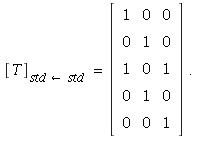 (For instance, the last column is
(For instance, the last column is
the coordinate vector of ![]()
d) (added part). Let ℬ = ![]()
We want ![]()
= ![]()


8. If ![]() then
then 
so ![]()
10. a)  and Vector[column](%id = 136777484) = Vector[column](%id = 135965388) and Vector[column](%id = 135965388) = Vector[column](%id = 136804588)+Vector[column](%id ...](images/PS8Sol_40.gif)
= ![]() Similarly,
Similarly, 
Therefore, T is a linear mapping.
b) By the definition,
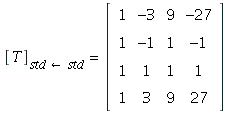
c) (added part)
![]()
= ![]()
= 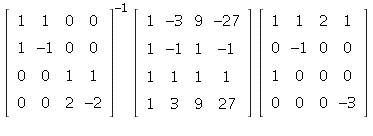
= 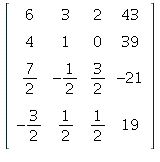
Section 5.1
2. If  then
then  has rank 1.
has rank 1.
There are nonzero vectors such as ](images/PS8Sol_50.gif) such that
such that
![]() Therefore
Therefore ![]() is an
is an
eigenvalue of ![]()
6. We have  Therefore,
Therefore,
this is an eigenvector of the given matrix with eigenvalue
![]()
8.  has determinant
has determinant ![]()
(expanding by cofactors along row 3). Hence it has
rank ≤ 2, and there are nonzero vectors x such that
![]() One such vector is
One such vector is ](images/PS8Sol_59.gif) (found from
(found from
the row-reduced echelon form of ![]() which is
which is

20. Since the dimension of the column space is 1,
the matrix is not invertible. This means that ![]()
so λ = 0 is an eigenvalue. ![]()
Span These are two linearly independent
These are two linearly independent
eigenvectors for the eigenvalue λ = 0. (Note: λ = 15 is
also an eigenvalue.)
24. The matrix  is one such matrix for any real value of a.
is one such matrix for any real value of a.
![]() so
so ![]() is the only eigenvalue.
is the only eigenvalue.
25. If λ is an eigenvalue of the invertible matrix A, then there
is a nonzero vector x such that ![]() Note that
Note that ![]()
since otherwise we would have a nonzero vector in ![]()
which is a contradiction to the Invertible Matrix Theorem. But
then from ![]() we can multiply both sides by
we can multiply both sides by ![]() to
to
yield ![]() Then divide through by λ to
Then divide through by λ to
obtain ![]() This equation shows that
This equation shows that ![]() is an eigenvalue
is an eigenvalue
of ![]()
26. If ![]() and
and ![]() is an eigenvector (nonzero) with eigenvalue
is an eigenvector (nonzero) with eigenvalue
![]() then
then ![]() implies
implies ![]()
But ![]() is the zero matrix so
is the zero matrix so ![]() (the zero vector), so
(the zero vector), so ![]()
Hence λ = 0.
36. The figure should show ![]() (the vector in the same direction
(the vector in the same direction
as v but 3 times as long), ![]() (the vector in the opposite
(the vector in the opposite
direction along the line spanned by ![]() and
and ![]()
found by the parallelogram law for vector addition.
| > |
![table( [( 1, 2 ) = 0, ( 2, 2 ) = 1, ( 1, 3 ) = -3, ( 1, 1 ) = 1, ( 2, 1 ) = 0, ( 2, 3 ) = -2, ( 3, 1 ) = 0, ( 3, 2 ) = 0, ( 3, 3 ) = 0 ] )](images/PS8Sol_90.gif)
| > |
![table( [( 1, 2 ) = -5, ( 2, 2 ) = 3, ( 1, 3 ) = 3, ( 1, 1 ) = 10, ( 2, 1 ) = -6, ( 2, 3 ) = -2, ( 3, 1 ) = 3, ( 3, 2 ) = -1, ( 3, 3 ) = 1 ] )](images/PS8Sol_92.gif)
| > |
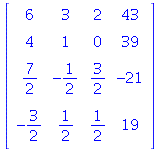
| > |